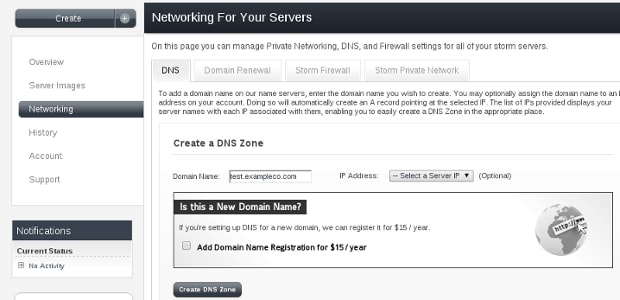Automating DNS With Zone Delegation and the Storm API
Although the term DNS zone delegation may seem new to you, you have been using zone delegation without even realizing it. When you tell your domain’s registrar what nameservers you are using for a particular domain, you are delegating the zone for that domain.
Single zone delegation will work for most people. In fact, most use a single zone file to reference multiple hosts, or multiple subdomains residing on a single host. However, there are cases where it may be beneficial to perform additional delegation.
For example, say that you run your nameservers via cPanel for the exampleco.com domain. However, you are planning on spinning up a significant amount of Storm Servers, and you want these servers to utilize test.exampleco.com as the domain portion of the Fully Qualified Domain Name (FQDN). You may not want to clutter up the example.com zone file with all the entries for the test.example.com hosts. You also may want to utilize Storm API calls to create the records.
As such, you will need to delegate the test.exampleco.com zone to Liquid Web’s nameservers.
How To Delegate Zones
The first thing we will need to do is create a test.example.com zone on Liquid Web’s nameservers.
To do this, log into your management interface, click networking, and click the DNS tab. Once there, enter test.exampleco.com into the create field and click create (you will not enter an IP address):

Once that is done, you will need to go to cPanel and edit the exampleco.com zone to let it know that Liquid Web is handling the resolution requests for the test.exampleco.com zone. Remember that NS record type that I mentioned earlier? This is where you will use it:

Once that is done, to verify things are working properly, run the following in a console:
dig NS test.exampleco.com
Under the answer section, it should show ns and ns1.sourcedns.com
Once this happens, Liquid Web’s nameservers will be resolving A records for hosts utilizing the test.exampleco.com domain. Now you could write a script to make the appropriate API calls to not only create servers en masse, but add the appropriate zone records as well.
===
Liquid Web’s Heroic Support is always available to assist customers with this or any other issue. If you need our assistance please contact us:
Toll-Free 1.800.580.4985
International 517.322.0434
support@liquidweb.com
https://manage.liquidweb.com/
Related Articles:

About the Author: Jason Gillman
Our Sales and Support teams are available 24 hours by phone or e-mail to assist.
Latest Articles
How to use kill commands in Linux
Read ArticleChange cPanel password from WebHost Manager (WHM)
Read ArticleChange cPanel password from WebHost Manager (WHM)
Read ArticleChange cPanel password from WebHost Manager (WHM)
Read ArticleChange the root password in WebHost Manager (WHM)
Read Article


